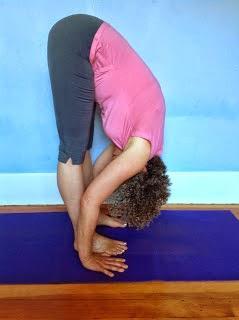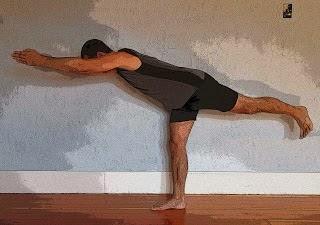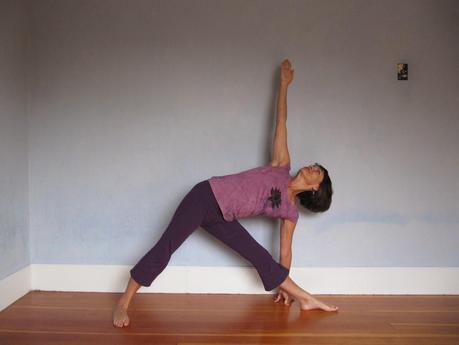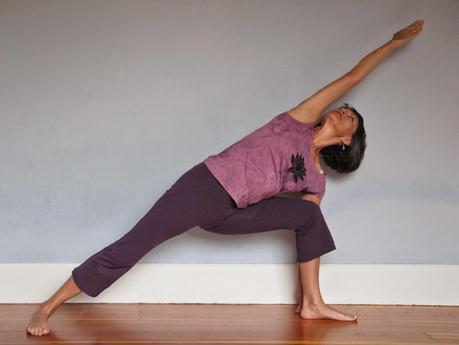
Hyperextending!
Typically it’s not me who writes about anatomical aspects of the asana practice. After all, we’ve got both Baxter, an MD who teaches anatomy to yoga teachers and Shari, a physical therapist who teaches anatomy to yoga teachers, on our staff. But after reading Baxter’s post about the standing leg and knee in Warrior 3 pose (Vrbradrasana 3), I decided to write about hyperextension in the knee joints in general because, you see, I have it myself. And I have been working with it in one way or another for about fifteen years (after it was pointed out to me by a couple of my teachers). I decided that since I had a lot of knowledge about it, it would be good to get it down in writing.As Baxter said in his post, hyperextension of the knee joint means that your knee joint has a slightly greater range of motion in extension than the average person’s does. In other words, in people with hyperextension of the knees, when the knee is straight, instead of the femur bone on top and the shinbones on bottom forming one straight line, your knee joint bows slightly backwards. I’d like to add to what Baxter said by observing that when your knees are hyperextended, your kneecaps don’t face straightforward; instead, they turn in slightly, with the inner edges pressing back more than the outer edges (making you look a bit knock kneed). Also, with hyperextended knees, you tend to bear more weight on your heels than on the balls of your feet and your thighs press back so they are not aligned directly over your shins. All this unevenness in your legs, knees and feet is the reason there is concern about hyperextension, with concern that it could lead to uneven wear and tear on the cushioning cartilage of your knee joint, which could result in dysfunction and pain down the road.
Rather than simply avoiding poses where you tend to hyperextend your knees, I believe that by observing the unevenness in your legs, knees and feet, and making adjustments, you can bring your legs, knees and feet into a healthier alignment. And in this post, I’m going to share with you how I do that myself.First I’ll recommend that you test yourself to see if you have hyperextension rather than knock knees, and then I’ll describe a few techniques for correcting your alignment, both as you move into and out of poses and while you are practicing them.Testing Yourself1. Start by standing in front of a mirror in Mountain pose (Tadasana), with your feet together (yes, together). Now look at your knees. Are they turning slightly in toward each other and coming closer together than the rest of your legs? This could be either a result of hyperextension or knock knees.2. Next, bend both knees by moving your shins forward and shift some of your weight from your heels to the balls of your feet. Then straighten your knees by lifting from your thighs, while keeping some of your weight in the balls of your feet.3. Look at your knees again. Are they now facing straightforward with more space between them? If so, you have corrected your hyperextended knees. If there is no change, you may have knock knees. But try the adjustment once more just in case.
Moving into Straight Leg Poses
The technique you just used to correct your hyperextended knees in Mountain pose test is one that you can use as you move into any straight-legged standing pose. For example, if you are moving into Warrior 3 (Vrbradrasana 3) or Half Moon Pose (Arda Chandrasana), where you bend your knee first and then straighten it, you will bend your knee by moving your shin forward and shifting some weight onto the ball of your foot. Then, as you straighten your leg to come in the pose, you would lift from your thigh to straighten your knee as you keep some weight in the ball of your foot. (As you come out of the pose, use the same techniques to bend and then straighten your knee.)
Warrior 3
For poses such as Triangle pose (Trikonasana) and Pyramid pose (Parsvottanasana) where you normally move into the pose with a straight leg, you can try changing the way you move into the pose, as it is the front knee in these poses that you tend to hyperextend. Using Triangle as an example, you would take the foot position for the pose and raise your arms out the sides. Then, bend your knee by moving your shin and shift some weight onto the ball of your foot. Next, as you come into Triangle pose, lift from your thigh to straighten your knee as you keep some weight in the ball of your foot. Does it feel different to you?Triangle Pose
Working in Straight Leg PosesWhen you’re already in a pose, you can make adjustments to bring your legs into healthier alignment. First, in any pose with a straight leg, even balancing poses such as Tree pose (Vrksasana), you can slightly bend your knee and then straighten it again using the technique I described above. One week I tested this technique with every single standing pose in Light on Yoga, and found benefits in almost every single pose. In many poses, such as Dancer’s pose (Natarjasana), this adjustment brought me deeper into the pose!Second, without bending your knee, you can try softening your front thigh muscles (quadriceps) and allow your thighbone (femur) to move slightly forward so it aligned more directly over your shinbone and more weight moves onto the ball of your foot. This will bring your leg into a straighter alignment. I just learn this one recently, and it works well in Half Moon pose (Arda Chandrasana).Working in Seated PosesIn seated poses with one or more straight legs, including forward bends and twists, people with hyperextension of the knees tend to press the knee of their straight leg down toward the floor when their foot is fully flexed (vertical), hyperextending the knee. So, instead of flexing your foot in these poses, try pushing the ball of your foot a bit past your heel (without pointing your toes). I call this the “Barbie foot,” as it looks like the doll’s feet without her high heels on, and I’ve noticed Iyengar uses this foot position. The result is that your knee no longer hyperextends and—additional bonus!—your hamstrings soften a bit because pressing your front foot forward loosens the tug on the calf muscle, which then loosens the tug on the hamstrings, allowing you to come more deeply into forward bends. Moving into Bent Leg PosesRemember that people who hyperextend tend to have knees that turn in slightly. So in weight-bearing poses with bent knees such as Warrior 1 and 2 (Vrbradrasana 1 and 2) or Extended Side Angle pose (Utthita Parsvakonasana), it’s a good idea to try to ensure that you’re bearing the weight evenly on your bent knee. Use the same technique of entering the pose by bending from your shin and moving some weight onto the ball of your foot. And, as you bend, pay attention to your inner back knee, deepening it as much as your outer back knee. This will help align your kneecap directly over your second and third toes and distribute your weight more evenly.
Extend Side Angle Pose
As you come out of the pose, use the same technique to straighten your leg as I described above, lifting from your thigh while keeping some weight on the ball of your foot. Thanks, Donald!Whew! That’s it for now. I’d like to end by saying that I learned almost all of this from my teacher Donald Moyer, both while I was training with him to become a yoga teacher and in his ongoing classes. I'm very grateful for all that and more....Subscribe to YOGA FOR HEALTHY AGING by Email ° Follow Yoga for Healthy Aging on Facebook




